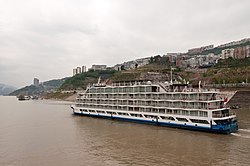Rugao
Rugao
如皋市 | |
|---|---|
 | |
| Coordinates: 32°14′46″N 120°35′28″E / 32.246°N 120.591°E[1] | |
| Country | People's Republic of China |
| Province | Jiangsu |
| Prefecture-level city | Nantong |
| Area | |
| • Total | 1,576.47 km2 (608.68 sq mi) |
| Population (2018) | |
| • Total | 1,241,700 |
| • Density | 790/km2 (2,000/sq mi) |
| Time zone | UTC+8 (China Standard) |
| Postal Code | 226500 |
| Rugao | |||||||||
|---|---|---|---|---|---|---|---|---|---|
| Chinese | 如皋 | ||||||||
| |||||||||
Rugao (Chinese: 如皋; pinyin: Rúgāo) is a county-level city under the administration of Nantong, Jiangsu province, China, located in the Yangtze River Delta on the northern (left) bank of the river.
History
[edit]
In 411, the western part of then Hailing (Taizhou) was separated from the county to create Rugao county, which named after a coastal village. During the Sui dynasty, the county was merged into Ninghai county. Restored in 952, the county was transferred to then Tongzhou in 1724.[2] Around the 1930s, Rugao was the most populous county in then Jiangsu province.[3] Two county governments of the New Fourth Army were established in the then county: Ruxi (literally Western Rugao) and Rugao (1940–5, was renamed as Rudong by the CPC in November 1945), while the Tongzhou-Yangzhou Canal marked the boundary between the two regions, during the Second Sino-Japanese War. Ruxi succeed to the designation Rugao in 1945, the reshuffling of territory came true only in January 1949, when the CPC totally controlled the area. On 1 June 1990, with approval of the State Council, Rugao was turned into a county-level city, which went into effect in 1991.[2]
Administrative divisions
[edit]At present, Rugao City has one subdistrict and 19 towns.[4]
- 1 subdistrict
- Rucheng (如城镇)
- 19 towns
Climate
[edit]| Climate data for Rugao (1991–2020 normals, extremes 1981–2010) | |||||||||||||
|---|---|---|---|---|---|---|---|---|---|---|---|---|---|
| Month | Jan | Feb | Mar | Apr | May | Jun | Jul | Aug | Sep | Oct | Nov | Dec | Year |
| Record high °C (°F) | 19.0 (66.2) |
25.6 (78.1) |
27.7 (81.9) |
32.4 (90.3) |
34.7 (94.5) |
37.0 (98.6) |
37.4 (99.3) |
38.0 (100.4) |
36.8 (98.2) |
32.0 (89.6) |
27.9 (82.2) |
22.5 (72.5) |
38.0 (100.4) |
| Mean daily maximum °C (°F) | 7.1 (44.8) |
9.4 (48.9) |
14.0 (57.2) |
20.1 (68.2) |
25.4 (77.7) |
28.4 (83.1) |
31.6 (88.9) |
31.1 (88.0) |
27.3 (81.1) |
22.5 (72.5) |
16.5 (61.7) |
9.8 (49.6) |
20.3 (68.5) |
| Daily mean °C (°F) | 2.7 (36.9) |
4.6 (40.3) |
8.7 (47.7) |
14.4 (57.9) |
19.8 (67.6) |
23.7 (74.7) |
27.5 (81.5) |
27.0 (80.6) |
23.0 (73.4) |
17.4 (63.3) |
11.3 (52.3) |
5.0 (41.0) |
15.4 (59.8) |
| Mean daily minimum °C (°F) | −0.6 (30.9) |
0.9 (33.6) |
4.5 (40.1) |
9.4 (48.9) |
14.9 (58.8) |
20.0 (68.0) |
24.2 (75.6) |
24.0 (75.2) |
19.5 (67.1) |
13.2 (55.8) |
7.1 (44.8) |
1.3 (34.3) |
11.5 (52.8) |
| Record low °C (°F) | −10.4 (13.3) |
−8.4 (16.9) |
−5.0 (23.0) |
−2.2 (28.0) |
4.8 (40.6) |
10.0 (50.0) |
16.5 (61.7) |
16.1 (61.0) |
9.3 (48.7) |
−0.3 (31.5) |
−3.8 (25.2) |
−13.4 (7.9) |
−13.4 (7.9) |
| Average precipitation mm (inches) | 50.9 (2.00) |
49.0 (1.93) |
74.5 (2.93) |
64.6 (2.54) |
92.1 (3.63) |
156.0 (6.14) |
206.4 (8.13) |
177.0 (6.97) |
91.7 (3.61) |
54.5 (2.15) |
56.9 (2.24) |
36.7 (1.44) |
1,110.3 (43.71) |
| Average precipitation days (≥ 0.1 mm) | 9.2 | 9.0 | 10.2 | 9.2 | 10.4 | 11.6 | 13.1 | 13.2 | 8.9 | 7.2 | 8.1 | 7.1 | 117.2 |
| Average snowy days | 2.9 | 2.6 | 0.7 | 0 | 0 | 0 | 0 | 0 | 0 | 0 | 0.2 | 0.7 | 7.1 |
| Average relative humidity (%) | 76 | 76 | 75 | 75 | 76 | 80 | 83 | 84 | 81 | 78 | 77 | 74 | 78 |
| Mean monthly sunshine hours | 125.3 | 127.4 | 155.3 | 178.3 | 182.2 | 135.5 | 170.1 | 186.6 | 167.3 | 169.3 | 140.3 | 142.2 | 1,879.8 |
| Percent possible sunshine | 39 | 41 | 42 | 46 | 43 | 32 | 39 | 46 | 46 | 49 | 45 | 46 | 43 |
| Source: China Meteorological Administration[5][6] | |||||||||||||
Education
[edit]- Baipu Middle school (1950)
Tourism
[edit]- Shuihui Garden
- Lingwei Taoist Temple
- Red Army Memorial Museum
Notable people
[edit]- Henry Lee, criminologist
- Zhu Qianhua, writer
- Huang Beijia, writer
- Xiaowei Zhuang, biophysicist
- Zhu Meifang, materials scientist
References
[edit]- ^ "Rugao" (Map). Google Maps. Retrieved 2014-07-02.
- ^ a b 中国历史地名大辞典 [The Great Encyclopaedia of Chinese Historical Toponyms]. p. 1154. ISBN 978-7-500-44929-4.
- ^ 江苏省志・人口志 [Jiangsu Provical Gazetteer, Volume on Demography]. Fangzhi Publishing House. pp. 90–8. ISBN 978-7-801-22526-9.
- ^ "南通市-行政区划网 www.xzqh.org" (in Chinese). XZQH. Retrieved 2012-05-24.
- ^ 中国气象数据网 – WeatherBk Data (in Simplified Chinese). China Meteorological Administration. Retrieved 25 June 2023.
- ^ 中国气象数据网 (in Simplified Chinese). China Meteorological Administration. Retrieved 25 June 2023.
External links
[edit]- (in Chinese) Rugao government
- (in Chinese) Rugao City English guide (Jiangsu.net)
- (in English and Chinese) "Illustrated Album of Yangzhou Prefecture", from 1573 to 1620, has illustrations of Rugao

